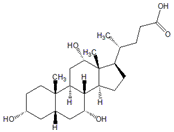Home
Products
Cholic acid



| Product Name | Cholic acid |
| Price: | $12 / 20mg |
| Catalog No.: | CN02575 |
| CAS No.: | 81-25-4 |
| Molecular Formula: | C22H40O5 |
| Molecular Weight: | 408.57 g/mol |
| Purity: | >=98% |
| Type of Compound: | Steroids |
| Physical Desc.: | White powder |
| Source: | The bile of Pig |
| Solvent: | Chloroform, Dichloromethane, Ethyl Acetate, DMSO, Acetone, etc. |
| SMILES: | O[C@@H]1CC[C@]2([C@@H](C1)C[C@H]([C@@H]1[C@@H]2C[C@H](O)[C@]2([C@H]1CC[C@@H]2[C@@H](CCC(=O)O)C)C)O)C |
| Contact us | |
|---|---|
| First Name: | |
| Last Name: | |
| E-mail: | |
| Question: | |
| Description | Cholic acid is a major primary bile acid produced in the liver and usually conjugated with glycine or taurine. It facilitates fat absorption and cholesterol excretion. |
| Target | Human Endogenous Metabolite |
| In Vitro | Cholic acid competitively binds Na+/taurocholate cotransporting polypeptide (NTCP) on HepG2 cells and significantly inhibits the uptake of Cholic acid (CA)-nanoliposomes (LPs)-Doxorubicin (DOX)-HCl, which indicates that CA-LPs-DOX-HCl are also uptaken via NTCP-mediated endocytosis pathway[1]. |
| In Vivo | Cholic acid feeding leads to increased CYP2D6 expression in CYP2D6-humanized mice. As a cholestasis model, Tg-CYP2D6 mice are fed a Cholic acid (CA)-supplemented diet for over 1 week. The treatment is known to increase bile acid pool size by 2-fold and to replace ~90% of bile acids with CA, recapitulating the features of cholestatic conditions in humans[2]. |
| Cell Assay | HepG2 cells are pretreated with the inhibitors NaN3 (1 mg/mL), Genistein (50 μg/mL), MβCD (10 mM), Nystatin (50 μg/mL), Chlorpromazine (10 μg/mL), and Cholic acid (1 mg/mL) for 30 min. After removing the inhibitors, the cells are incubated with CA-LPs for 2 h, and the cellular uptake of LPs is determined in the "In vitro cellular uptake assays" section[1]. |
| Animal Admin | Mice[2] Tg-CYP2D6 mice are fed with normal chow (control) or 1% (w/w) Cholic acid-supplemented diet (CA) for 14 days (n=4 mice/group). Alkaline phosphatase (ALP) and alanine aminotransferase (ALT) activities are measured in mouse serum. |
| Density | 1.2±0.1 g/cm3 |
| Boiling Point | 583.9±50.0 °C at 760 mmHg |
| Flash Point | 321.0±26.6 °C |
| Exact Mass | 408.287567 |
| PSA | 97.99000 |
| LogP | 2.62 |
| Vapour Pressure | 0.0±3.7 mmHg at 25°C |
| Storage condition | 2-8°C |